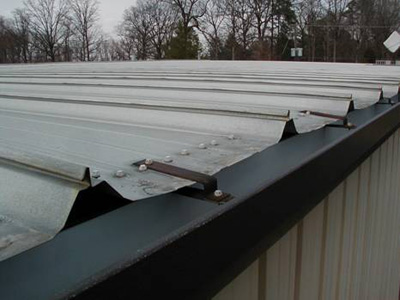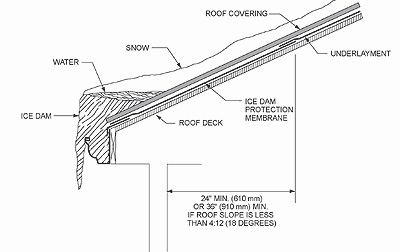The industry terms perfection and royal mean inch and inch lengths
coverings installed on slopes exceeding 3:12 (14 degrees).
Low-slope roofing
o
Reinforcement — reinforcement adds strength, puncture resistance and dimensional stability to a
membrane.
Steep-slope roofing
There are six generic classifications of steep slope roof coverings.
Underlayment — underlayment provides temporary protection until a roof covering is installed and provides a secondary weatherproofing barrier. Sometimes underlayment is referred to as "felt" or "paper."
Roof covering — the roof covering is the external watershedding material.
Material and system description
Surfacings for built up roof systems include aggregate (such as gravel, slag or mineral granules), glass-fiber or mineral surfaced cap sheets, hot asphalt mopped over the entire surface, aluminum coatings or elastomeric coatings.
2
NRCA does not make any recommendations about which product or manufacturer to use; however, NRCA does recommend that bitumens, felts and mats used for BUR systems meet standards established by ASTM International.
The following commonly referenced ASTM International standards apply to materials used in the construction of BUR systems:
ASTM D2824, "Standard Specification for Aluminum Pigmented Asphalt Roof Coatings, Nonfibered, Asbestos Fibered, and Fibered without Asbestos"
ASTM D3909, "Standard Specification for Asphalt Roll Roofing (Glass Felt) Surfaced With Mineral Granules"
When purchasing a new roof system, there will be two warranties to consider. First, there will be the manufacturer's warranty. In general, these warranties cover defects in the manufacture of the roof membrane. Please read for more information. Once the project is complete, be sure the contractor provides you with a certificate for your records.
Second, the roofing contractor will provide you with a warranty covering his workmanship. Typically, this will cover installation and related issues. The warranty should contain what items are covered and what will void them. Many contractors offer one year or two years of coverage; however, there is no industry standard.
Example of a structural metal panel roof system
Underlayment (or "felt paper" as it is frequently called) is installed over the roof deck before the application of a metal panel roof system. An underlayment performs two primary functions: it provides temporary weather protection until the metal panel roof is installed, and it provides a secondary weatherproofing barrier if moisture infiltrates the metal roof panels.
Underlayments typically are not used with structural metal panel roof systems when intermittent supports are used to carry the roof systems. However, if there is a continuous or closely spaced roof deck, NRCA recommends an underlayment be installed.
5
Material standards
NRCA does not make any recommendations about which product or manufacturer to use; however, NRCA does recommend that metal roof systems meet standards established by ASTM International.
the manufacturer's warranty. In general, these warranties cover defects in the manufacture of the
roof covering. In the case of met
Second, the roofing contractor will provide you with a warranty covering his workmanship.
Typically, this will cover installation and related issues. The warranty should contain what items
APP polymer-modified bitumen membranes typically are heat-welded or torch-applied. Consumers should be cautioned that NRCA does not recommend torch-applying a modified bitumen membrane sheet directly to a wood deck.
Generally, APP modifiers impart a "plasticized" quality to asphalt, and SBS modifiers impart a "rubberized" quality to asphalt. MB membranes and EPDM, a thermoset membrane, often are confused by consumers because of colloquialisms used by roofing contractors. MB and EPDM membranes are sometimes called "rubber roofs."
A roof system composed of a built up roof membrane with 2 plies or 3 plies and a polymer-modified bitumen membrane cap sheet is commonly referred to as "hybrid" system. NRCA considers this type to be a polymer modified bitumen membrane system.
Material standards
SBS polymer modified bitumen products:
ASTM D6162, "Standard Specification for Styrene Butadiene Styrene (SBS) Modified Bituminous Sheet Materials Using a Combination of Polyester and Glass Fiber Reinforcements"
Warranties
When purchasing a new roof system, there will be two warranties to consider. First, there will be the manufacturer's warranty.e roof membrane. Please read for more information. Once the project is complete, be sure the contractor provides you with a certificate for your records.
A finished sheet's thickness typically is referred to as mil thickness; 1 mil equals 0.001 inch. Common mil thicknesses for these sheet membranes range from 30 mils to 60 mils.
Single-ply membranes can be installed fully adhered, mechanically attached or held down with ballast. Most single-ply roof systems do not receive surfacings.
Polyvinyl Chloride (PVC)
PVC Alloys or Compounded Thermoplastics
Thermoplastic Olefin (TPO)
Chlorinated Polyethylene (CPE)
Sheets are typically 45 mils to 90 mils thick.
Seams are sealed by heat or chemical welding.
Sheet widths range from 6 feet to 12 feet wide
Sheets are typically 40 mils to 100 mils thick
PVC and TPO roof membranes can be installed fully adhered, mechanically attached or
ballasted. Most PVC and TPO membranes do not receive surfacings.
ASTM D4434, "Standard Specification for Poly(Vinyl Chloride) Sheet Roofing"
ASTM D6878, "Standard Specification for Thermoplastic Polyolefin Based Sheet
roof membrane. Please read
for more information. Once the project is complete, be sure the contractor provides you with a
are covered and what will void them. Many contractors offer one year or two years of coverage;
however, there is no industry standard.
Material and system description
Thermoset membranes incorporate principal polymers that are chemically cross linked or
Ethylene propylene diene terpolymer (EPDM)
Chlorosulfonated polyethylene (CSPE)
compounds, ethylene and propylene, that are derived from oil and natural gas. The following are
some characteristics of EPDM roof membranes:
EPDM roof membranes can be installed fully adhered, mechanically attached (using batten bars)
or ballasted. Most EPDM membranes do not receive surfacings.
Example of a ballasted EPDM roof system
EPDM and often are confused by consumers because of colloquialisms used by roofing contractors. Contractors commonly call both of these membranes "rubber" roofs. However, in most cases, when contractors specify rubber roofs, they are referring to EPDM.
13
ASTM D7067, "Standard Specification for Reinforced White PIB Sheet Used in Roofing Membrane"
The second component, the protective surfacing, typically is a spray applied elastomeric coating, though hand and power rollers can be used. The protective surfacing also can be a membrane, such as a fleece backed thermoset single ply membrane. The purpose of the surfacing is to provide weatherproofing, protect the foam from UV exposure, provide protection from
mechanical damage and assist with the fire-resistant characteristic of the roof system.
14
Silicone
Aromatic Polyurethane Elastomer
Conditions such as wind speed, sunlight, surface moisture, humidity and temperature of the substrate can affect the reaction of the polyurethane foam.
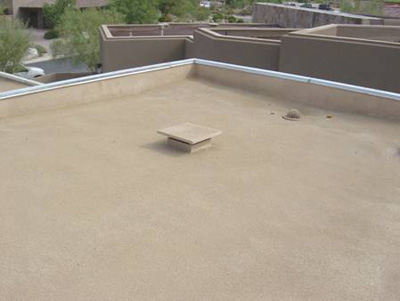
ASTM C1029, "Specification for Spray Applied Rigid Cellular Polyurethane Thermal
Insulation"
Coating Used in Spray Polyurethane Foam Roofing System"
ASTM D7425, "Standard Specification for Spray Polyurethane Foam Used for Roofing
roof membrane. Please read
for more information. Once the project is complete, be sure the contractor provides you with a
however, there is no industry standard.
16
Asphalt shingles are composed of: a base material, either organic felt or glass-fiber mat, that provides support for the weather-resistant components and gives a shingle strength; asphalt and fillers; and surfacing material, generally in the form of mineral granules, that provides protection from impact and UV degradation and improves fire resistance.
The most common form of asphalt shingles are strip shingles. They are rectangular, the most prevalent size being 12 inches wide by 36 inches long. Metric shingles are 13 1/4 inches by 39 3/8 inches. Strip shingles most frequently have three tabs that are exposed along the length of the shingle for visual effect and are called 3 tab strip shingles.
17
Caution should be exercised when roof decks are constructed out of the following materials:
It is not uncommon for it to rain after the contractor installs underlayment but before he installs the asphalt shingles. The underlayment gets wet and becomes wrinkled. If the wrinkling isn't severe enough to affect the shingle installation (i.e. the wrinkling won't telegraph through the shingles and they won't appear buckled or wavy once installed), the underlayment probably can remain in place. The effects of wrinkling also will be minimized by using heavier weight shingles.
Asphalt saturated, nonperforated organic felts are among the most common underlayments used for shingles; they commonly are designated as Type 15 and Type 30 or referred to as No. 15 and No. 30, which are reflective of a once used pound per square weight designation. The terms Type I and Type II now are used within the industry in lieu of No. 15 or No. 30, respectively.
An ice dam protection membrane should be applied starting at a roof's eaves and extending upslope a minimum of 24 inches from the exterior wall line of a building. For slopes less than 4:12 (18 degrees), NRCA recommends a minimum of 36 inches. See Figure 1.
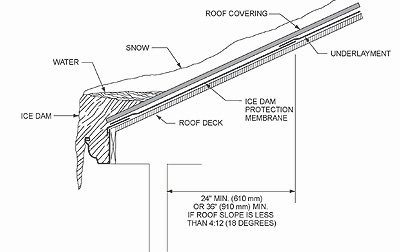
Flashings for asphalt shingle roof systems fall into four categories: perimeter edge metal, penetrations, valleys and vertical surfaces. See Figure 2.
Perimeter edge metal: Depending on the severity of climate, anticipated rainfall and freeze-thaw cycling, the use of perimeter edge metal should be considered.
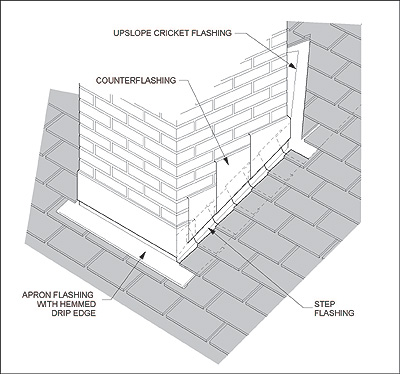
Figure 2—Basic sheet metal flashing components
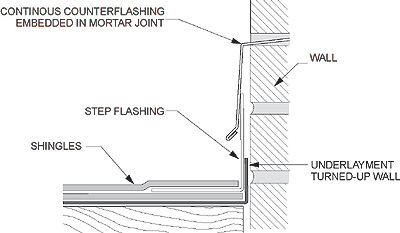
Figure 4—Example of through-wall metal counterflashing embedded in masonry mortar joint
Organic asphalt shingles should meet ASTM D225, "Standard Specification for Asphalt Shingles (Organic Felt) Surfaced With Mineral Granules."
Fiberglass asphalt shingles should meet ASTM D3462, "Standard Specification for Asphalt Shingles Made from Glass Felt and Surfaced with Mineral Granules."
roof covering. The period of coverage can range from 20 years to a lifetime. Please read
for more information. Once the project
however, there is no industry standard.
2.2 Clay tile and concrete tile
surface texture treatments applied. As a result, there are a wide variety of tile profiles, styles,
finishes and colors available. In addition, there may be separate accessory tiles—matched to each
Example of a clay tile roof
22
Caution should be exercised when roof decks are constructed out of the following materials:
Oriented strand board (OSB): NRCA is concerned with potential fastener-holding problems and dimensional stability because of the effects of moisture where OSB and other nonveneer products are used as roof decking.
Underlayment (or "felt paper" as it is frequently called) is installed over the roof deck before the application of tile. An underlayment performs two primary functions: it provides temporary weather protection until the tile is installed, and it provides a secondary weatherproofing barrier if moisture infiltrates the tile roof covering. Many tile roofs have outlived the underlayment felts over which they were installed. Therefore, an underlayment's service life should be comparable to the design service life of the tile roof covering.
23
An ice dam protection membrane should be applied starting at a roof's eaves and extending upslope a minimum of 24 inches from the exterior wall line of a building. For slopes less than 4:12 (18 degrees), NRCA recommends a minimum of 36 inches. See Figure 1.
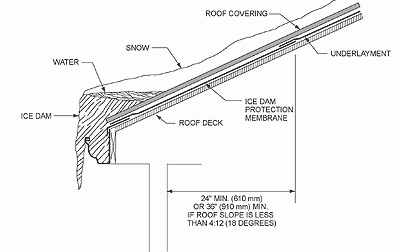
Nails—Nailing is the most common method. NRCA recommends that roofing nails be 11- gauge or 12-gauge galvanized steel or the equivalent corrosion-resistant roofing nails. Nail heads should be low-profile, smooth and flat. Shanks should be barbed or otherwise deformed for added pull-out strength. Nails should be long enough to penetrate through all layers of roofing materials and extend through the underside of the roof deck or penetrate at least 3/4 inch into wood plank or board decks.
Wire tie and strapping systems—Hanging tile with wire is used on non-nailable decks, insulated decks or where fastening through metal flashings needs to be avoided.
Flashings for tile roofs fall into four categories: perimeter edge metal, penetrations, valleys and vertical surfaces. See Figure 2.
Perimeter edge metal-depending on the severity of climate, anticipated rainfall and freeze-thaw cycling, the use of perimeter edge metal should be considered.
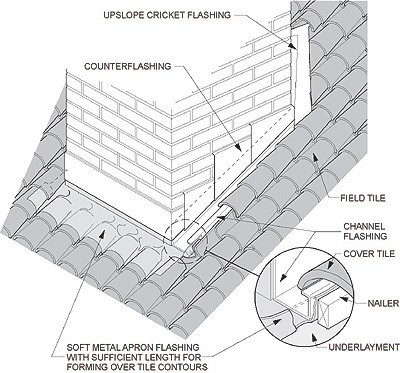
Figure 2—Basic sheet metal flashing components
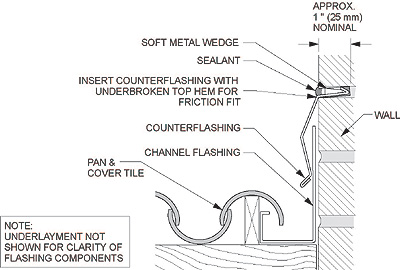
Figure 4—Example of through-wall metal counterflashing embedded in masonry mortar joint
ASTM C1167, "Standard Specification for Clay Roof Tiles"
ASTM C1492, "Standard Specification for Concrete Roof Tile"
Second, the roofing contractor will provide you with a warranty covering his workmanship. Typically, this will cover installation and related issues. The warranty should contain what items are covered and what will void them. Many companies offer one year or two years of coverage; however, there is no industry standard.
2.3 Metal roof systems for steep-slope applications
28
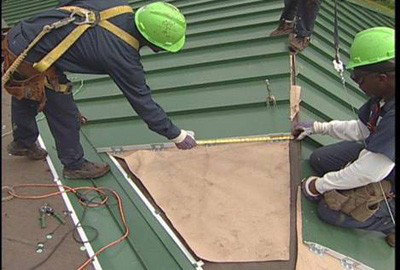
Metal shingles and shingle panels are available in numerous varieties for use as steep-slope roof coverings. Most of the metal shingles are press-formed during the manufacturing process to provide a variety of shapes. These products can take the shape of individual or multiple asphalt, tile, slate or wood shingle configurations.
29
Example of standing seam profiles
A flat seam is created with individual panels applied in a shingled application. One panel edge is folded back on top of itself; the other panel is folded under, and the two panels are hooked together. Again, because flat panels are considered watershedding, they are more commonly found in architectural installations. Some flat seam panel systems, such as copper, are commonly soldered, which allows them to perform on less steep slopes.
Architectural metal panel roof systems and structural metal panel roof systems are installed over a large variety of substrates. There are two general categories of substrates: continuous or closely spaced decking that provides solid support for the metal roof panel, and the other is composed of spaced structural supports (such as purlins) where the metal panels must span between supports. Most structural metal panels are used over spaced structural supports without being supported by a solid roof deck.
Metal shingles and metal shingle panels should be installed over continuous or closely spaced wood decking, furring strips, or metal or wood purlins using a batten or counter-batten system.
For metal panel roof systems, metal shingles and metal shingle panels, NRCA recommends a minimum of one layer of No. 30 asphalt-saturated felt applied horizontally in shingle fashion on roof decks having a slope of 4:12 (18 degrees) or more. For roof decks having slopes of 3:12 (14 degrees) up to 4:12 (18 degrees), a minimum of two layers of No. 30 asphalt-saturated
underlayment should be applied horizontally in shingle fashion.Underlayments typically are not used with structural metal panel roof systems when intermittent supports are used to carry the roof systems. However, if there is a continuous or closely spaced
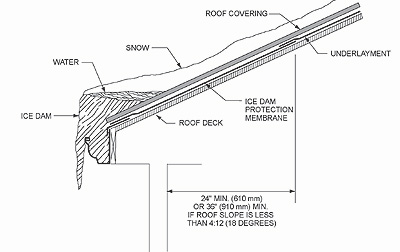
Figure 1—Example of ice damming
NRCA does not make any recommendations about which product or manufacturer to use; however, NRCA does recommend that metal roof systems meet standards established by ASTM International.
ASTM E1514, "Standard Specification for Structural Standing Seam Steel Roof Panel Systems"
the manufacturer's warranty. In general, these warranties cover defects in the manufacture of the
roof covering. In the case of metal roof systems, manufacturers tend to cover only the metal
Typically, this will cover installation and related issues. The warranty should contain what items
are covered and what will void them. Many contractors offer one year or two years of coverage;
Roofing slate is a dense, durable, naturally occurring material that is essentially nonabsorbent. Two properties of slate are cleavage and fracture. It has natural cleavage, which permits it to be easily split in one direction. Fracture, usually occurring at right angles to the cleavage, is called the grain. Roofing slate commonly is split so the length of the slate runs in the direction of the grain. The surface texture of slate after being split for commercial use derives from the characteristics of the rock from which it was quarried. Some slate splits to a smooth, practically even surface, while other yields a surface that is rough and uneven.
The color of slate is determined by its chemical and mineral composition. Because these factors differ in various regions, roofing slate can be obtained in a variety of colors. In addition, exposure to weather causes slate to change color. The degree of change varies depending on the slate. Slate exhibiting minimal color change is known as "permanent" or "unfading" slate. Slate that shows a more marked color change is known as "weathering" slate. Between unfading slate and weathering is "semi weathering" slate.
Roof deck
NRCA recommends slate be applied over continuous or closely spaced wood decking. When plywood is used, NRCA recommends the use of a minimum 5/8 thick nominal exterior-grade plywood.
34
Underlayment
In locations where the average temperature for January is 30º F or less, NRCA suggests installation of an ice-dam protection membrane. An ice-dam protection membrane generally is a self-adhering polymer-modified bitumen membrane.
An ice dam protection membrane should be applied starting at a roof's eaves and extending upslope a minimum of 24 inches from the exterior wall line of a building. For slopes less than 4:12 (18 degrees), a minimum of 36 inches is recommended. See Figure 1.
NRCA suggests the use of copper slating nails for slate. NRCA does not recommend unprotected black-iron and electroplated nails. NRCA recommends nails for standard-sized slate are sharp-point, 3/8 inch large flat head, copper-wire slating nails. Nails should be long enough to penetrate through all layers of roofing materials and extend through the underside of the roof deck or penetrate at least 3/4 inch into wood plank or board decks. All roofing slate should have a minimum of two nails, however, slate subject to high-wind conditions and/or thicker slate should be fastened with four nails.
Flashings
Vertical surfaces: When a roof system abuts a vertical surface, there are four types of flashing commonly used: apron, step, cricket (or backer) and counterflashing.
36
Figure 3—Example of through-wall metal counterflashing inset in masonry mortar joint
37
Material standards
NRCA does not make any recommendations about which tile or manufacturer to use; however, NRCA does recommend clay tile roof coverings meet standards established by ASTM International.
38
roof covering or in the case of slate, failure in the slate itself. Please read
are covered and what will void them. Many contractors offer one year or two years of coverage;
however, there is no industry standard.
Cedar shakes and cedar shingles are available pressure treated with fire retardants and chemical preservatives for increased fire resistance and to prevent premature rot and decay in some climates.
Pine shakes are made from southern yellow pine and are taper sawn. They also are available pressure treated with preservatives to protect against decay and insects. Interlayment felts are required for pine shakes.
nominal exterior-grade plywood for 16-inch rafter spacings and 5/8 inch nominal thickness for 24-inch rafter spacings. For OSB, NRCA recommends a minimum 15/32 inch thick or 1/2 inch nominal exterior-grade OSB for 16-inch rafter spacings.
Caution should be exercised when roof decks are constructed out of the following materials:
Asphalt saturated, nonperforated organic felts are among the most common underlayments used for wood shakes and wood shingles; they commonly are designated as Type 15 and Type 30 or referred to as No. 15 and No. 30, which are reflective of a once used pound per square weight designation. The terms Type I and Type II now are used within the industry in lieu of No. 15 or No. 30, respectively.
When underlayment (or "felt paper" as it is frequently called) is specified, No. 15 or No. 30 asphalt-saturated, nonperforated felt should be applied shingle fashion on roof decks having a slope of 4:12 (18 degrees) or more. NRCA does not recommend using wood shakes and wood shingles on slopes less than 4:12 (18 degrees).
In locations where the average temperature for January is 30º F or less, NRCA suggests installation of an ice-dam protection membrane. An ice-dam protection membrane generally is a self-adhering polymer-modified bitumen membrane.
An ice dam protection membrane should be applied starting at a roof's eaves and extending upslope a minimum of 24 inches from the exterior wall line of a building. For slopes less than 4:12 (18 degrees), NRCA recommends a minimum of 36 inches. See Figure 2.
41
Flashings
Vertical surfaces: When a roof system abuts a vertical surface, there are four types of flashing commonly used: apron, step, cricket (or backer) and counterflashing.
Apron, step and cricket flashings require some form of counterflashing to cover and protect the
Figure 3—Example of through-wall metal counterflashing inset in masonry mortar joint
42
Material standards
43
2.6 Synthetic
Despite the benefits, there are some significant drawbacks. Synthetic roof coverings are relatively new and there isn't a proven track record about their performance. Most synthetic
44

